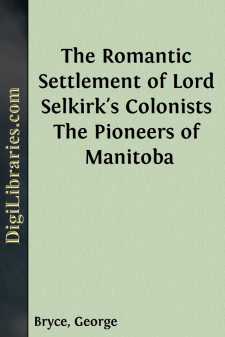Categories
- Antiques & Collectibles 13
- Architecture 36
- Art 48
- Bibles 22
- Biography & Autobiography 813
- Body, Mind & Spirit 142
- Business & Economics 28
- Children's Books 17
- Children's Fiction 14
- Computers 4
- Cooking 94
- Crafts & Hobbies 4
- Drama 346
- Education 46
- Family & Relationships 57
- Fiction 11829
- Games 19
- Gardening 17
- Health & Fitness 34
- History 1377
- House & Home 1
- Humor 147
- Juvenile Fiction 1873
- Juvenile Nonfiction 202
- Language Arts & Disciplines 88
- Law 16
- Literary Collections 686
- Literary Criticism 179
- Mathematics 13
- Medical 41
- Music 40
- Nature 179
- Non-Classifiable 1768
- Performing Arts 7
- Periodicals 1453
- Philosophy 64
- Photography 2
- Poetry 896
- Political Science 203
- Psychology 42
- Reference 154
- Religion 513
- Science 126
- Self-Help 84
- Social Science 81
- Sports & Recreation 34
- Study Aids 3
- Technology & Engineering 59
- Transportation 23
- Travel 463
- True Crime 29
The Romantic Settlement of Lord Selkirk's Colonists The Pioneers of Manitoba
by: George Bryce
Categories:
Description:
Excerpt
CHAPTER I.
THE EARLIER PEOPLE.This is the City of Winnipeg. Its growth has been wonderful. It is the highwater mark of Canadian enterprise. Its chief thoroughfare, with asphalt pavement, as it runs southward and approaches the Assiniboine River, has a broad street diverging at right angles from it to the West. This is Broadway, a most commodious avenue with four boulevards neatly kept, and four lines of fine young Elm trees. It represents to us "Unter den Linden" of Berlin, the German Capital.
The wide business thoroughfare Main Street, where it reaches the Assiniboine River, looks out upon a stream, so called from the wild Assiniboine tribe whose northern limit it was, and whose name implies the "Sioux" of the Stony Lake. The Assiniboine River is as large as the Tiber at Rome, and the color of the water justifies its being compared with the "Yellow Tiber."
The Assiniboine falls into the Red River, a larger stream, also with tawny-colored water. The point of union of these two rivers was long ago called by the French voyageurs "Les Fourches," which we have translated into "The Forks."
One morning nearly forty years ago, the writer wandered eastward toward Red River, from Main Street, down what is now called Lombard Street. Here not far from the bank of the Red River, stood a wooden house, then of the better class, but now left far behind by the brick and stone and steel structures of modern Winnipeg.
The house still stands a stained and battered memorial of a past generation. But on this October morning, of an Indian summer day, the air was so soft, that it seemed to smell wooingly here, and through the gentle haze, was to be seen sitting on his verandah, the patriarch of the village, who was as well the genius of the place.
The old man had a fine gray head with the locks very thin, and with his form, not tall but broad and comfortable to look upon, he occupied an easy chair.
The writer was then quite a young man freshfrom College, and with a simple introduction, after the easy manner of Western Canada, proceeded to hear the story of old Andrew McDermott, the patriarch of Winnipeg.
"Yes," said Mr. McDermott, "I was among those of the first year of Lord Selkirk's immigrants. We landed from the Old Country, at York Factory, on Hudson Bay. The first immigrants reached the banks of the Red River in the year 1812.
"I am a native of Ireland and embarked with Owen Keveny—a bright Hibernian—a clever writer, and speaker, who, poor fellow, was killed by the rival Fur Company, and whose murderer, De Reinhard, was tried at Quebec. Of course the greater number of Lord Selkirk's settlers were Scotchmen, but I have always lived with them, known them, and find that they trust me rather more than they at times trust each other. I have been their merchant, contractor, treaty-maker, business manager, counsellor, adviser, and confidential friend."
"But," said the writer, "as having come to cast in my lot with the people of the Red River, I should be glad to hear from you about the early times, and especially of the earlier people of this region, who lived their lives, and came and went, before the arrival of Lord Selkirk's settlers in 1812." Thus the story-telling began, and patriarch and questioner made out from one source and another the whole story of the predecessors of the Selkirk Colonists.
...


